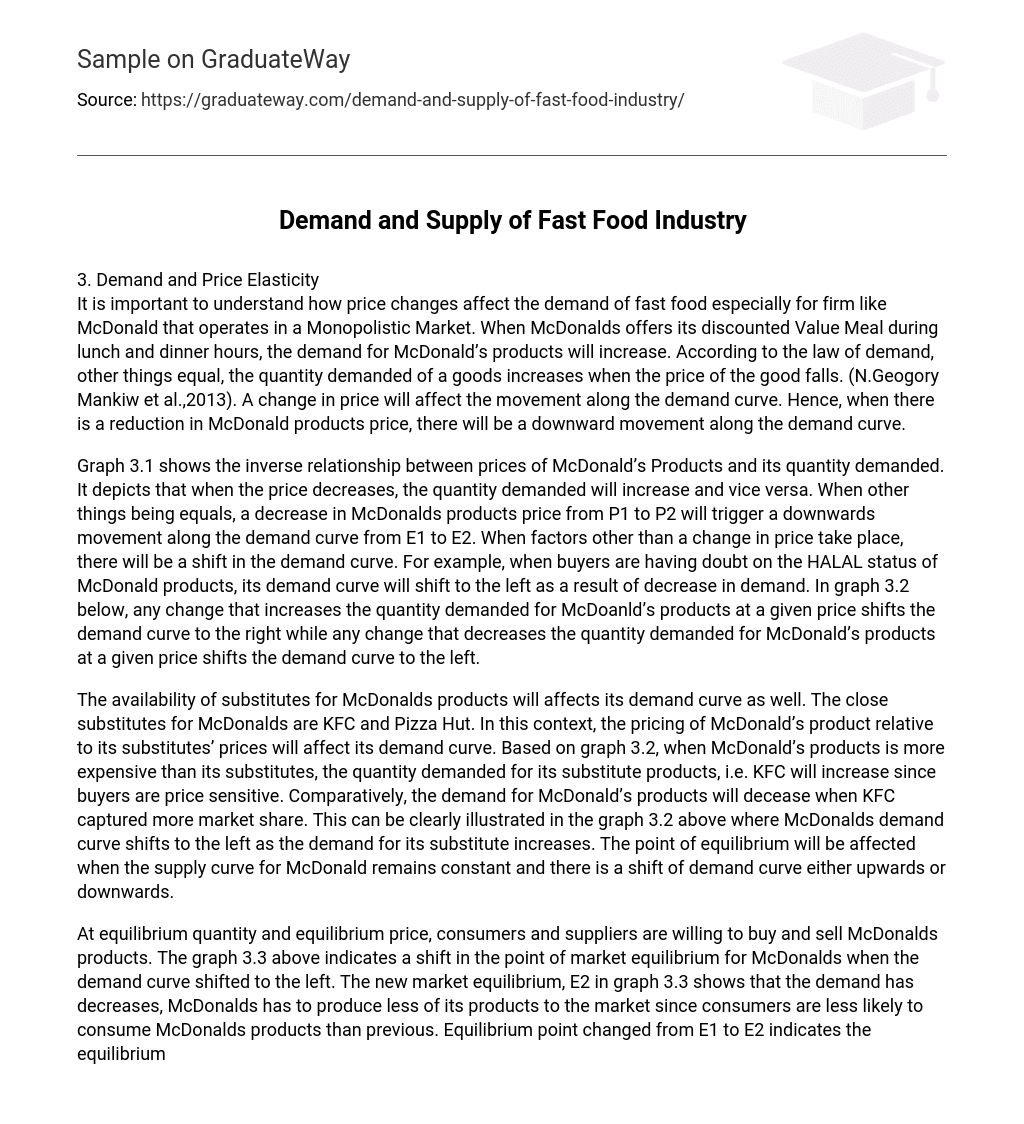3. Demand and Price Elasticity
It is important to understand how price changes affect the demand of fast food especially for firm like McDonald that operates in a Monopolistic Market. When McDonalds offers its discounted Value Meal during lunch and dinner hours, the demand for McDonald’s products will increase. According to the law of demand, other things equal, the quantity demanded of a goods increases when the price of the good falls. (N.Geogory Mankiw et al.,2013). A change in price will affect the movement along the demand curve. Hence, when there is a reduction in McDonald products price, there will be a downward movement along the demand curve.
Graph 3.1 shows the inverse relationship between prices of McDonald’s Products and its quantity demanded. It depicts that when the price decreases, the quantity demanded will increase and vice versa. When other things being equals, a decrease in McDonalds products price from P1 to P2 will trigger a downwards movement along the demand curve from E1 to E2. When factors other than a change in price take place, there will be a shift in the demand curve. For example, when buyers are having doubt on the HALAL status of McDonald products, its demand curve will shift to the left as a result of decrease in demand. In graph 3.2 below, any change that increases the quantity demanded for McDoanld’s products at a given price shifts the demand curve to the right while any change that decreases the quantity demanded for McDonald’s products at a given price shifts the demand curve to the left.
The availability of substitutes for McDonalds products will affects its demand curve as well. The close substitutes for McDonalds are KFC and Pizza Hut. In this context, the pricing of McDonald’s product relative to its substitutes’ prices will affect its demand curve. Based on graph 3.2, when McDonald’s products is more expensive than its substitutes, the quantity demanded for its substitute products, i.e. KFC will increase since buyers are price sensitive. Comparatively, the demand for McDonald’s products will decease when KFC captured more market share. This can be clearly illustrated in the graph 3.2 above where McDonalds demand curve shifts to the left as the demand for its substitute increases. The point of equilibrium will be affected when the supply curve for McDonald remains constant and there is a shift of demand curve either upwards or downwards.
At equilibrium quantity and equilibrium price, consumers and suppliers are willing to buy and sell McDonalds products. The graph 3.3 above indicates a shift in the point of market equilibrium for McDonalds when the demand curve shifted to the left. The new market equilibrium, E2 in graph 3.3 shows that the demand has decreases, McDonalds has to produce less of its products to the market since consumers are less likely to consume McDonalds products than previous. Equilibrium point changed from E1 to E2 indicates the equilibrium price has fallen and the equilibrium quantity increase.
Graph 3.4 illustrates the changes in market equilibrium when the price fall, it initiate the movement along the demand curve and increase the amount of quantity demanded. The point D0 moves downward along the demand curve to point D1 when the price falls from P1 to P2. As a result, the new market equilibrium is derived at the point of D1. The supply of McDonald product will be affected by a reduction in price. At the price of P1, there will be a surplus of McDonald products in the market; supply more than demand. In this circumstance, the supply of McDonald products will be adjusted accordingly in Monopolistic market to achieve the new market equilibrium point, i.e. D1.
According to Tatiana Adreyeva et al.,2010, food away from home was most responsive to changes in prices among other categories (0.81). This indicates that demand for fast food is highly elastic since the quantity demanded responds substantially to changes in price.
As fast food is extremely price elastic, a slight change in price can affect its sales significantly. When McDonalds reduces it products price relative to its competitors, the quantity demanded for McDonald products will raise and the total revenue will increase. Hence, pricing is the major concern for buyer in making purchase decision, if one becomes much cheaper than the others, the majority of the buyer will switch despite of their personal
preferences.
Besides the availability of substitutes, the demand for fast food products is also affected by its convenience in reaching for its. Buyers are seeking more convenience services offered by foodservice providers nowadays. By expanding its area of delivery services, McDonald value shares among burger fast food has increase to almost 84% in 2010. (Mohd Zulkeflee Adb Razak & Azleen Ilias, 2013) More demands are expected for McDonald delivery service as there is no minimum purchase requirement for home delivery.
Apart from delivery services, McDonald provides the convenience to its buyer by having more drive-thru outlets knowing that Malaysians are becoming increasingly time poor due to heavier work load and hectic social lifestyle. By capitalizing on buyer needs, there is potential for creating more demand for McDonald products. According to Sarah Casanova, McDonald’s Malaysia managing director, McDonald is aiming to double the number of restaurants it has in Malaysia to 500 by 2020. McDonald’s Malaysia recorded its higher market share of 42% within two years in the local quick service restaurant segment in the Klang Valley. (The STAR, June 2013)
References
Tatiana Andreyeva, Michael W.Long, and Kelly D. Brownell (2012), The Impact of Food Prices on Consumption: A systematic Review of Research on the Price Elasticity Demand for Food. Wong Wei Shen (2013, June 6). Retrieved from www.thestar.com.my N.Gregory Mankiw et al., 2013, Principle of Economics, Malaysia Edition, Cengage Learning Asia Pte Ltd, page 59





